

Le cerveau à tous les niveaux. Le cerveau à tous les niveaux. Disturbances of visual motion perception in bipolar disorder - O'Bryan - 2014 - Bipolar Disorders. Group music therapy for patients with persistent post-traumatic stress disorder – an exploratory randomized controlled trial with mixed methods evaluation - Carr - 2011 - Psychology and Psychotherapy: Theory, Research and Practice.
Towards a theory of intentional behaviour change: Plans, planning, and self-regulation - Sniehotta - 2010 - British Journal of Health Psychology. Association québécoise de prévention du suicide. Ejaculation précoce - définition. L’éjaculation précoce ou prématurée est, avec la dysfonction érectile (= problèmes d'érection), le trouble de la sexualité masculine le plus fréquent.
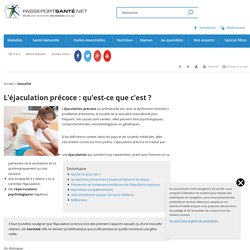
Ses causes sont variées : elles peuvent être psychologiques, comportementales, neurobiologiques ou génétiques. Si les définitions varient selon les pays et les sociétés médicales, elles s’accordent toutes sur trois points. L’éjaculation précoce se traduit par : une éjaculation qui survient trop rapidement, avant que l'homme ou sa partenaire ne le souhaitent et ce, systématiquement ou très souvent; une incapacité à « retenir » ou à contrôler l’éjaculation ; des répercussions psychologiques négatives. On distingue : l’éjaculation précoce primaire qui est présente à chaque rapport, avec des partenaires différentes, durant toute la vie. Qui est touché par l'éjaculation précoce ? Selon de nombreuses études, l’éjaculation précoce concernerait 20 à 30% des hommes1. Causes de l'éjaculation précoce Les causes exactes sont toutefois inconnues. PsycARTICLES - The validation of a self-report measure of posttraumatic stress disorder: The Posttraumatic Diagnostic Scale.
The validation of a self-report measure of posttraumatic stress disorder: The Posttraumatic Diagnostic Scale.
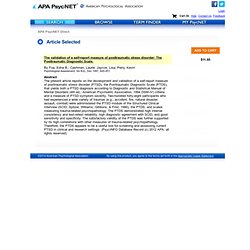
By Foa, Edna B.; Cashman, Laurie; Jaycox, Lisa; Perry, Kevin Psychological Assessment, Vol 9(4), Dec 1997, 445-451. Abstract The present article reports on the development and validation of a self-report measure of posttraumatic stress disorder (PTSD), the Posttraumatic Diagnostic Scale (PTDS), that yields both a PTSD diagnosis according to (4th ed.; American Psychiatric Association, 1994 ) criteria and a measure of PTSD symptom severity.
Quitting smoking: 10 ways to ride out tobacco cravings. Quitting smoking: 10 ways to resist tobacco cravings Tobacco cravings can wear you down when you're trying to quit smoking or chewing tobacco.
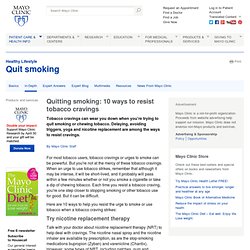
Delaying, avoiding triggers, yoga and nicotine replacement are among the ways to resist cravings. By Mayo Clinic Staff For most tobacco users, tobacco cravings or urges to smoke can be powerful. But you're not at the mercy of these tobacco cravings. Here are 10 ways to help you resist the urge to smoke or use tobacco when a tobacco craving strikes: Try nicotine replacement therapy Talk with your doctor about nicotine replacement therapy (NRT) to help deal with cravings.
After reviewing decades of research, the Food and Drug Administration recently announced that there's no significant safety concerns associated with using more than one OTC NRT at the same time. Avoid triggers Delay Chew on it Give your mouth something to do to fight a tobacco craving. Psycnet.apa.org/psycarticles/2013-43980-001.pdf&productCode=pa. Resource Activation in Generalized Anxiety—An Observer-Based Microprocess Analysis of Patients’ In-Session Outcomes.
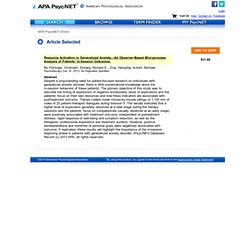
By Flückiger, Christoph; Zinbarg, Richard E.; Znoj, Hansjörg; Ackert, Michael Psychotherapy, Dec 16 , 2013, No Pagination Specified. Abstract Despite a long-standing need for patient-focused research on individuals with generalized anxiety disorder, there is little systematized knowledge about the in-session behaviors of these patients. The primary objective of this study was to describe the timing of expression of negative emotionality (level of explication) and the patients’ focus on their own resources and how these indicators are associated with posttreatment outcome. Psycnet.apa.org/psycarticles/2013-45435-001.pdf&productCode=pa.
Change in Self-Discrepancy, Anxiety, and Depression in Individual Therapy.

By Watson, Neill; Bryan, Brandon C.; Thrash, Todd M. Psychotherapy, Dec 30 , 2013, No Pagination Specified. Abstract This study tested hypotheses of change in the real–ideal (RI) and real–ought (RO) self-discrepancies over the course of therapy, based on Rogers’s (1959) theory of personality change in therapy. Before and after therapy with 20 therapists of diverse theoretical orientations at a university counseling center, 99 undergraduate and graduate students completed three instruments that measure both self-discrepancies: the Self-Concept Questionnaire—Personal Constructs, the Self-Concept Questionnaire—Conventional Constructs, and the Abstract Measures.
PsycNET - Browse Volumes. Psycnet.apa.org/psycarticles/2013-45434-001.pdf&productCode=pa. Brief Cognitive Therapy for Avoidant Personality Disorder.
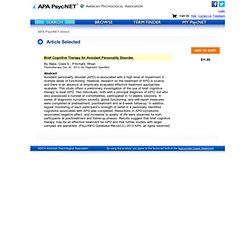
Psycnet.apa.org/psycarticles/2013-45425-001.pdf&productCode=pa. Clinical processes in behavioral couples therapy.

By Fischer, Daniel J.; Fink, Brandi C. Psychotherapy, Vol 51(1), Mar 2014, 11-14. Abstract Behavioral couples therapy is a broad term for couples therapies that use behavioral techniques based on principles of operant conditioning, such as reinforcement. Behavioral shaping and rehearsal and acceptance are clinical processes found across contemporary behavioral couples therapies.
Psycnet.apa.org/psycarticles/2013-39412-001.pdf. PsycNET - Option to Buy. Ecological momentary assessment of stressful events and negative affect in bulimia nervosa.

By Goldschmidt, Andrea B.; Wonderlich, Stephen A.; Crosby, Ross D.; Engel, Scott G.; Lavender, Jason M.; Peterson, Carol B.; Crow, Scott J.; Cao, Li; Mitchell, James E. Journal of Consulting and Clinical Psychology, Vol 82(1), Feb 2014, 30-39. Abstract Objective: Negative affect precedes binge eating and purging in bulimia nervosa (BN), but little is known about factors that precipitate negative affect in relation to these behaviors. We aimed to assess the temporal relation among stressful events, negative affect, and bulimic events in the natural environment using ecological momentary assessment. Psycnet.apa.org/psycarticles/2013-42381-001.pdf&productCode=pa. The profile of executive function in OCD hoarders and hoarding disorder.